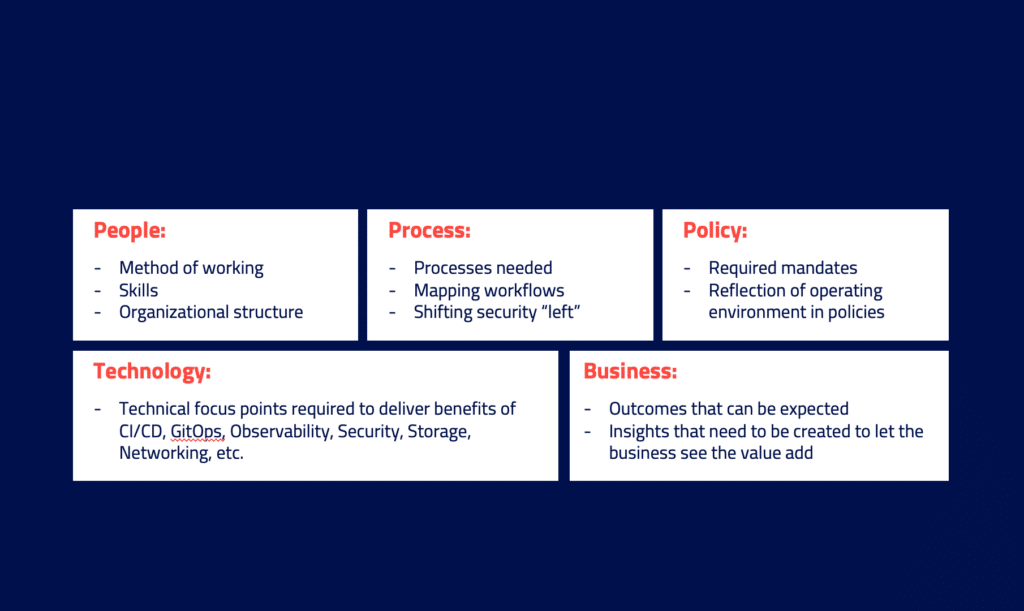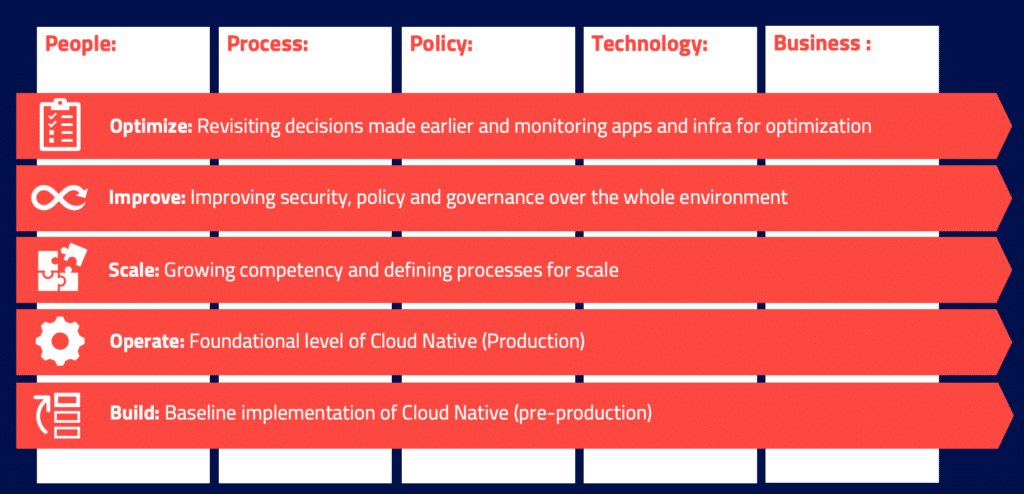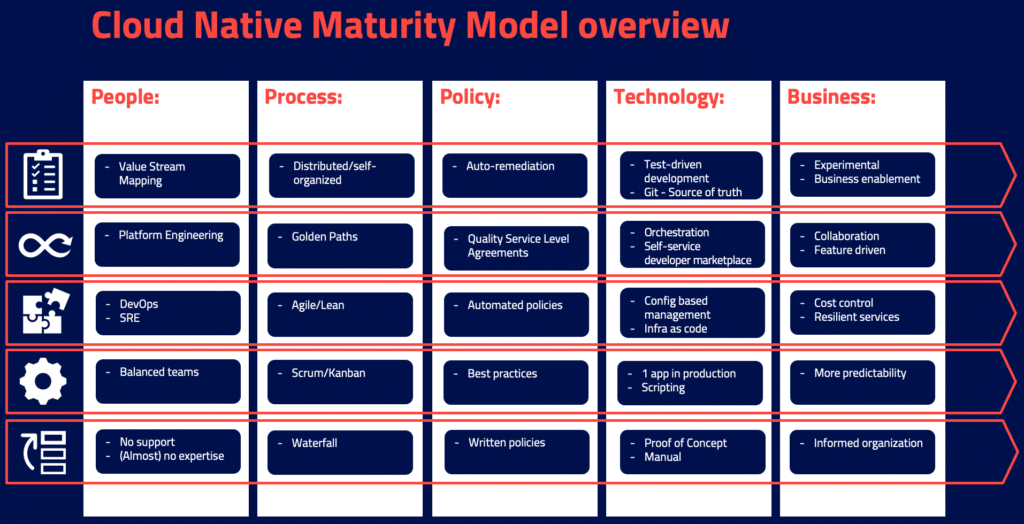Your guide to mastering the Cloud Native landscape
In today's fast-paced digital landscape, we're seeing an intriguing evolution unfold. A majority of organizations now boast an in-house troupe of software developers, all diligently crafting codes, algorithms, and applications. Despite adopting Agile, Scrum, and DevOps methodologies, many find that emulating the streamlined efficiency of software juggernauts like Netflix or Spotify remains an elusive goal.In the bygone era of software development, creating a piece of software was an exercise in patience. The lack of automation often stretched the development timeline thin. And yes, while modern methodologies have significantly accelerated the production line, they've also brought with them a more demanding release schedule. This uptick in release frequency carries with it an inherent risk - the increased probability of release failure.
To counter this risk, companies pour resources into meticulous planning, in-depth research, and extensive evidence-gathering before embarking on new feature development. But this approach has its drawbacks, creating a self-perpetuating cycle of an ever-growing workload that extends beyond just crafting code.
Enter the realm of Cloud Native. Its prime objective? Break this cycle. Foster an environment where more time is dedicated to software development, allowing for swift experimentation, and creating a safe space for failure, learning, and adaptation. And ultimately, achieving market success.
As a quick reminder of what Cloud Native entails, you can refer back to my inaugural blog post in the Cloud Native Chronicles series: What is this Cloud Revolution for IT Success?
As an IT Transformation Manager at ITQ, I'm often found at the frontlines, ensuring the successful integration and adoption of new technologies. Lately, my attention has been captivated by Cloud Native technologies. These are still new, but I'm really excited about how they could change the future of technology. Of course, using these new technologies comes with its own set of challenges. My work involves finding these problems and coming up with ways to make the adoption process easier. My goal is to help organizations take full advantage of the power of Cloud Native technologies.
The maturity spectrum - are you Cloud Native yet?
As I've had the pleasure (and sometimes the challenge) to work with a various organization, it's always fascinating to notice the wide array of Cloud Native adoption stages each one sits at. Yes, the game of Cloud Native is like golf; it's not about the competition but your personal best. You may see all sorts of swings out there, some trying to break par, others simply trying not to lose their balls.
When it comes to the adoption of Cloud Native practices, there's no 'one-size-fits-all' approach. Businesses differ like snowflakes, not just from company to company but even within different sections of the same organization. This kaleidoscope of adoption takes on all forms, from the platform underpinning operations to the internal developer platforms, and even how the business units align themselves within the organization.
In the race to become Cloud Native, it's easy to find yourself caught in a Groundhog Day loop, tirelessly trying to reach that elusive 'Cloud Native' status but making little headway. We're often seduced by the shiny promise of Cloud Native. Yet, when we tumble down the rabbit hole, we find it's not as straightforward as implementing the latest techno-widgets, adopting some new lingo, or a hasty combo of both.
Truth be told, there's more to the Cloud Native story than meets the eye. And no, it doesn't involve magic wands or secret handshakes. This is why we've crafted a model that offers a comprehensive view of what it means to become truly Cloud Native, showing you what being truly Cloud Native looks like and how you can start taking small, bite-sized steps in the right direction. After all, even the most epic adventures start with a single step!
Before we embark - some ground rules
Let's get one thing straight. This model isn't a sat-nav, with a perky voice telling you to take the next exit onto 'Cloud Native Drive'. Nor is it an IKEA instruction manual (who reads those anyway?). Think of it more like a Bear Grylls style survival guide - helping you navigate the star-studded wilderness of the Cloud Native landscape towards your chosen destination.
We're not promising an all-seeing oracle here. Instead, we aim to broaden your horizons, enlightening you on the rich tapestry that is Cloud Native, empowering you with the know-how to make savvy decisions. Remember, knowledge is power, and who doesn't want to be the Dumbledore of their IT department?
However, it's crucial to understand that this model is not a scorecard. It's not about hitting level 5 and throwing a wild office party with cake and balloons (although cake is always a good idea). Your business might be pitch-perfect sitting comfortably at level 3, while a 'cloud born' company, unburdened by legacy baggage, may seem to pole vault over a few levels.
Just like humans, each company has unique goals. Comparing a local municipality with a tech giant like Amazon is like comparing a unicycle to a race car. Sure, they both have wheels, but their ambitions, and the paths they take, will differ. Amazon may squeeze out business benefits from cutting-edge software development methods, whereas others might focus more on upskilling and achieving stability rather than transforming business outcomes. Nevertheless, making a meaningful impact on the organization is a shared mission across the board.
Lastly, this guide isn't here to preach why Cloud Native is your golden ticket. Instead, it serves as a thoughtful tool to provoke internal discussions around how Cloud Native can nestle snugly into your organization or how it can be turbo-charged if it's already part of your strategy.
Attributes of a Cloud Native maestro
At the heart of the ITQ Cloud Native Maturity Model lie attributes that distinguish those Cloud Native rockstars who consistently churn out chart-topping hits. It underscores that harmonizing People, Process, Policy, Technology and Business, all choreographed to the tune of your business rhythm, is key to crafting that masterpiece.
Our model breaks down the journey into five major attributes:

Journey through maturity level land
To reach a certain level of maturity, all the attributes need to be balanced around that level. It's like a well-tuned orchestra, where each instrument plays its part to create a beautiful symphony. Striving towards a maturity level helps set the right expectations within the organization, providing an insight into what your Cloud Native adventure may entail.
Your Cloud Native journey can range from the early 'I'm just testing the waters' stage at level one ("Build"), where ROI is a far-off land, to the zenith of Cloud Native mastery, akin to the Netflixes, Spotifies and Ubers of the world. At level 5 ("Optimize"), these Cloud Native maestros are no longer just playing the game; they're changing it, using Cloud Native strategies to disrupt and dominate markets.
In our experience, maintaining a balanced approach to Cloud Native investments across these attributes is the secret sauce for long-term success. Although it's not the end of the world to be more advanced in one attribute than another, we've observed that excessive imbalances or prolonged discrepancies can lead to inefficient allocation of your Cloud Native investments, be it money, time, energy or even work happiness.
Below, you'll find a snapshot of the different stages in the Cloud Native journey, each with its unique flavor:

The ITQ Cloud Native Maturity Model at a glance
To make this model actionable, we've identified the most crucial capability to cultivate at each maturity level for every attribute. These have been distilled into one or two "high-level capabilities" per section.
Here's a glimpse of the capabilities you'd need to master at each level for each attribute:

By cultivating these capabilities, you'll have all the tools you need to progress through the Cloud Native maturity levels like a seasoned mountaineer ascending Everest!
Words of caution (and wisdom)
Now, I get it. Glancing over that overview, you might feel like you've accidentally stepped into a buzzword bingo hall. Sure, we could spend days debating the nitty-gritty meanings of these capabilities. Fortunately, we've got SMART criteria for every capability within ITQ that can help clarify things. We didn't include them in the overview to avoid turning it into a novel. If you'd like to dive into those details, I'm always game!
Yes, there's no shortage of maturity models available in the Cloud Native sphere. This isn't some revelation claiming to be the ultimate beacon of truth. However, where I found most of them lacking was in their holistic view of an organization's maturity. They often spotlight the tech, offering fantastic (even superior) overviews of the tech stack and concepts vital for this journey. But, they often miss the mark on the necessary processes to extract real value from that technology or how teams interact with it. Our model, on the other hand, aims to provide a panoramic view, helping you see the whole Cloud Native forest, not just the tech trees.
Some sage advice before we kick off
If I could offer one nugget of wisdom to those embarking on their Cloud Native voyage, it would be not to try and swallow the entire Cloud Native sandwich in one bite. Don't overwhelm yourself by tackling all the attributes at once. It's wiser to start by understanding your current maturity level in each attribute. That's often where we at ITQ step in, assisting companies in plotting this out. You might find that in some areas, your organization is already a Cloud Native Ninja, meaning you don't have to go all guns blazing at all the attributes simultaneously.
Change, while exciting, needs to be doled out at a pace digestible to your organization. An onslaught of simultaneous transformations can cause friction faster than rubbing two sticks together. And that's the last thing we want. It's about embracing the capabilities over time, one by one, allowing your organization to acclimatize to the new altitude without gasping for breath.
As the Cloud Native transition gains momentum, it's evident that the various parts of an IT organization need to start singing from the same hymn sheet. This isn't a new concept. We've seen similar transitions in the past. Remember the era before virtualization? We had the IT departments neatly sectioned into silos, with specialists pigeonholed into specific domains like compute, storage, or network. However, the rise of software-defined data centers and Infrastructure as a Service (IaaS) melted those silos faster than an ice cream cone on a summer day.
The initial standardization of this new, abstracted layer was challenging, with a large quantity of unique requirements screaming for bespoke solutions. But with time, the standardization of virtualized infrastructure became as mainstream as sliced bread. And mind you, we Dutch folk take our bread slicing very seriously. We're witnessing a similar evolution with Cloud Native tech, where the abstraction layer is being hoisted even higher.
The trick, dear readers, is to give the maturity model time to simmer, planning it over a longer timeline. Going full throttle into being fully Cloud Native overnight could be as taxing as running a marathon without training. But if organizations shy away from this journey entirely because of the perceived challenge, they risk missing out on the long-term Cloud Native goodness and might even lose to the market's more adventurous trailblazers. So buckle up and enjoy the ride; it's well worth it!



